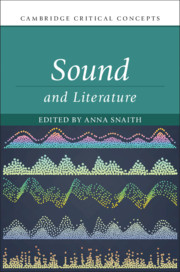Book contents
- Sound and Literature
- Cambridge Critical Concepts
- Sound and Literature
- Copyright page
- Epigraph
- Contents
- Figures
- Contributors
- Acknowledgements
- Introduction
- Part I Origins
- Chapter 1 Hearing and the Senses
- Chapter 2 Fragments on/of Voice
- Chapter 3 Sonic Forms
- Chapter 4 Classical Music and Literature
- Chapter 5 Aesthetics, Music, Noise
- Part II Development
- Part III Applications
- Bibliography
- Index
Chapter 5 - Aesthetics, Music, Noise
from Part I - Origins
Published online by Cambridge University Press: 29 May 2020
- Sound and Literature
- Cambridge Critical Concepts
- Sound and Literature
- Copyright page
- Epigraph
- Contents
- Figures
- Contributors
- Acknowledgements
- Introduction
- Part I Origins
- Chapter 1 Hearing and the Senses
- Chapter 2 Fragments on/of Voice
- Chapter 3 Sonic Forms
- Chapter 4 Classical Music and Literature
- Chapter 5 Aesthetics, Music, Noise
- Part II Development
- Part III Applications
- Bibliography
- Index
Summary
The chapter specifically explores the Futurist aesthetics of noise as manifested in Luigi Russolo’s ‘noise machines,’ or ‘intonarumori.’ Noise, and composition with noises, folds in with the Futurists’ general affirmation of technological modernity and with their related aesthetic practices extolling the virtues of speed, violence and war. The chapter also ponders Futurist noise and its relationship to twelve-tone dissonance, and discovers a common spiritualist thread linking these musical formal practices. For Russolo, at least, the technical and spiritualist connections relate to Leonardo da Vinci’s own plans for music machines, and his general view art’s ‘spirituality.’
Keywords
- Type
- Chapter
- Information
- Sound and Literature , pp. 114 - 132Publisher: Cambridge University PressPrint publication year: 2020

